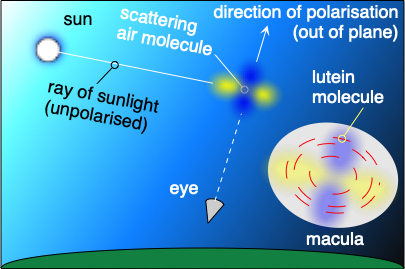Haidinger's butterfly* – our sixth sense
Carlo Beenakker, Instituut-Lorentz, Leiden University
published in Dutch in Nederlands Tijdschrift voor Natuurkunde, June 2018
"Many a laboratory physicist is astonished and inclined to disbelieve us when we tell him that we are able to see with our naked eye, unaided by any instrument, that the light from the sky is polarized!" This is how the Dutch astronomer Marcel Minnaert starts out his description of Haidinger's brushes, in Light and Color in the Outdoors.
I read the book as a teenager and immediately decided to develop this power vision. Minnaert advises to train your eye at dusk and I diligently followed his recommendation: "Practice a few times daily for a few minutes at a time. After a day or two, you will be able to distinguish Haidinger's brush fairly easily when you look at the blue sky." Quite soon I could share in the joy of Minnaert at the discovery of this sixth sense: "It is very pleasing to be able to determine the direction of polarization without an instrument in this way, and even to obtain an estimate of its degree."
Several decades later this effect became a topic in my electromagnetism course, when I explained the polarisation of Rayleigh scattering. The same mechanism responsible for the blue color of the sky is also responsible for the linear polarisation of the scattered sunlight (see figure). The light vibrates perpendicularly to the plane sun-air-molecule-eye and in that direction the field of view shows a faint blue plume, interrupted by a yellow plume pointing towards the sun. The butterfly shaped object fades quickly, you might think it was just an imagination, but by shifting your gaze it reappears. To distinguish the butterfly from other faint images that may appear on the retina I used the fact that the yellow body of the butterfly does not rotate as you rotate your head: it keeps pointing towards the sun.
I was lucky: Helmholtz writes he needed twelve years of practice to see the butterfly with his own eyes. He was the first to give an explanation for the effect: dichroism of the macula. A polarisation dependent absorption coefficient is however not sufficient for the detection of the polarisation, the molecules should also have a preferential orientation. The elongated molecules of the lutein pigment, arranged along a circle in the macula, absorb preferentially light that is polarized parallel to the long axis (see figure). There exists a consensus that this molecule is primarily responsible for the effect, but surprises remain: A century after Haidinger's 1844 report it was discovered that the butterfly also appears for circularly polarised light.
An altogether different puzzle is whether travellers at sea in antiquity used this sixth sense for navigation. Did the Vikings, en route to America, know where the sun was hiding behind the clouds because the butterfly pointed in that direction?
*Wilhelm Haidinger (1795-1871) called the image a Büschel in German, meaning tuft or bundle. The English translation "brush" is less accurate. I follow David Auerbach in calling it Haidinger's butterfly.
